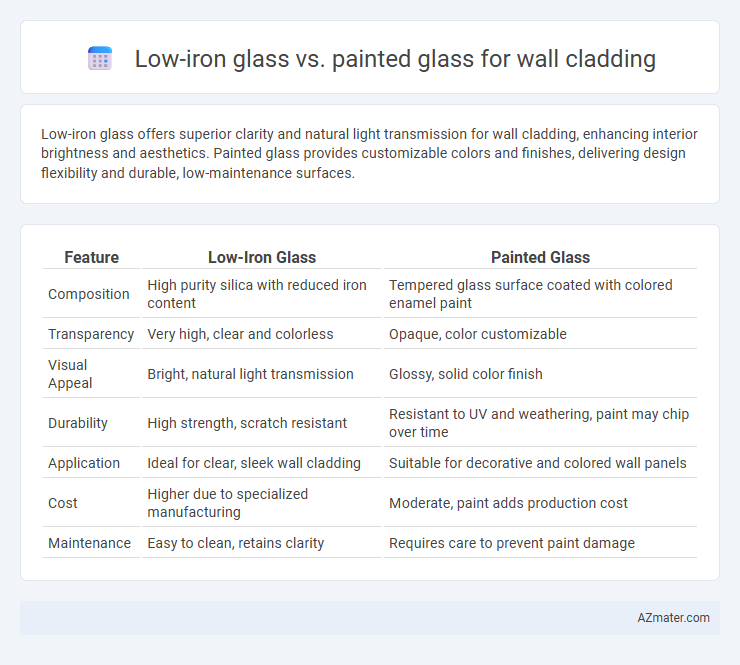Low-iron glass offers superior clarity and natural light transmission for wall cladding, enhancing interior brightness and aesthetics. Painted glass provides customizable colors and finishes, delivering design flexibility and durable, low-maintenance surfaces.
Table of Comparison
| Feature | Low-Iron Glass | Painted Glass |
|---|---|---|
| Composition | High purity silica with reduced iron content | Tempered glass surface coated with colored enamel paint |
| Transparency | Very high, clear and colorless | Opaque, color customizable |
| Visual Appeal | Bright, natural light transmission | Glossy, solid color finish |
| Durability | High strength, scratch resistant | Resistant to UV and weathering, paint may chip over time |
| Application | Ideal for clear, sleek wall cladding | Suitable for decorative and colored wall panels |
| Cost | Higher due to specialized manufacturing | Moderate, paint adds production cost |
| Maintenance | Easy to clean, retains clarity | Requires care to prevent paint damage |
Introduction to Glass Options for Wall Cladding
Low-iron glass offers exceptional clarity and a near-colorless appearance, making it ideal for wall cladding where a pristine, modern aesthetic is desired. Painted glass, on the other hand, provides versatility in color and finish, allowing for custom designs and enhanced visual impact while maintaining durability and ease of maintenance. Both options contribute to architectural innovation but cater to different stylistic and functional priorities in wall cladding applications.
What is Low-Iron Glass?
Low-iron glass is a type of glass produced with minimal iron content, resulting in higher clarity and enhanced light transmission compared to standard glass, making it ideal for wall cladding applications where natural light and visual transparency are priorities. It offers superior color accuracy and reduces the greenish tint commonly seen in regular glass, ensuring a sleek, modern aesthetic for architectural designs. Unlike painted glass, which uses a layer of paint for color and finish, low-iron glass maintains its clarity and durability without surface coatings that may degrade over time.
Understanding Painted Glass
Painted glass for wall cladding offers vibrant color options and customization through various paint finishes, providing a sleek, modern aesthetic suitable for interior and exterior surfaces. Unlike low-iron glass, which is prized for its clarity and minimal green tint, painted glass emphasizes decorative appeal and can incorporate UV-resistant coatings to maintain color durability. Its installation flexibility and ease of cleaning make painted glass a popular choice for achieving bold visual impact in architectural applications.
Visual Clarity and Color Accuracy: A Comparison
Low-iron glass offers superior visual clarity and color accuracy compared to painted glass, as it contains significantly less iron oxide, reducing the green tint common in standard glass and allowing true-to-life color representation of the underlying surfaces. Painted glass, while customizable in color, may obscure natural light transmission and distort color perception due to the opaque coating applied on its surface. For wall cladding applications where maintaining vibrant, accurate colors and maximum transparency is essential, low-iron glass provides a clearer, more visually appealing finish.
Durability and Maintenance of Low-Iron vs Painted Glass
Low-iron glass offers superior durability compared to painted glass due to its high resistance to scratches and weathering, making it ideal for long-lasting wall cladding applications. Painted glass requires regular maintenance to prevent paint peeling and fading caused by UV exposure and moisture. The low-iron glass's inherent clarity combined with minimal maintenance needs ensures sustained aesthetic appeal and structural integrity over time.
Cost Considerations: Low-Iron Glass vs Painted Glass
Low-iron glass typically incurs higher initial costs due to its enhanced clarity and purity, making it a premium choice for wall cladding applications where aesthetics are paramount. Painted glass offers a more budget-friendly option, with lower material and installation expenses while providing versatile color customization. Long-term cost factors include potential maintenance, with low-iron glass resisting discoloration better than painted surfaces, which may require periodic repainting or touch-ups.
Light Transmission and Reflection Differences
Low-iron glass offers higher light transmission rates, typically above 90%, enhancing natural daylight penetration in wall cladding applications compared to painted glass, which significantly reduces light passage due to its opaque coating. Painted glass increases surface reflection, often exceeding 10%, creating a more reflective facade that can affect building aesthetics and energy efficiency. The choice between low-iron and painted glass directly impacts daylighting performance and solar heat gain control, critical factors in architectural design.
Installation Process and Challenges
Low-iron glass offers superior clarity and uniform light transmission, making its installation precise and requiring meticulous handling to avoid damage and ensure clean joins in wall cladding projects. Painted glass, often used for vibrant color effects, necessitates careful surface preparation and specialized adhesives to maintain paint durability and prevent peeling during installation. Both materials demand professional expertise, with low-iron glass focusing on fragility and alignment, while painted glass requires attention to the coating's chemical compatibility and curing conditions.
Aesthetic Appeal and Design Versatility
Low-iron glass offers a clearer, more transparent look with minimal green tint, enhancing aesthetic appeal by allowing true colors and natural light to shine through, ideal for modern, sleek wall cladding designs. Painted glass provides unlimited design versatility, as it can be customized with various colors, patterns, and finishes to create bold visual statements or subtle accents in interior and exterior wall applications. Combining low-iron glass with painted sections can achieve both superior clarity and dynamic design options, catering to diverse architectural styles and enhancing overall visual impact.
Choosing the Right Glass for Your Wall Cladding Needs
Low-iron glass offers superior clarity and natural light transmission, making it ideal for wall cladding projects where a sleek, transparent look is desired. Painted glass provides vibrant color options and enhanced privacy, suitable for decorative or statement walls needing customized aesthetics. Selecting the right glass depends on balancing the need for brightness and clarity against the desire for color and privacy features in your architectural design.

Infographic: Low-iron glass vs Painted glass for Wall cladding
 azmater.com
azmater.com